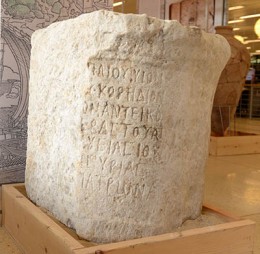
Inscription Reveals Governor of Judea Before the Bar-Kokhba Revolt
Robin Ngo
Who was the Roman governor of Judea during the time leading up to the Bar-Kokhba revolt, the second Jewish revolt against Rome (132-136 C.E.)? This question has now been answered thanks to an inscribed stone block recently discovered off the coast of Tel Dor in northern Israel.
The enormous block was first observed underwater in the Dor Nature Reserve by research students Ehud Arkin-Shalev and Michelle Kreisher from the Coastal Archaeology and Underwater Survey Lab at the University of Haifa. The significance of the block was evident because it bore an ancient inscription, and authorities determined that it must be extracted from the waters. Assaf Yasur-Landau, a professor in the Department of Maritime Civilizations at Haifa, headed the underwater excavation to bring the stone to dry land for study and conservation.
Gil Gambash, chair of the Department of Maritime Civilizations at Haifa, is in the process of deciphering the Greek inscription on the massive 0.7-ton, 2.8-feet-high stone. Haaretz reports that the inscription was reconstructed to read: "The City of Dor honors Marcus Paccius, son of Publius, Silvanus Quintus Coredius Gallus Gargilius Antiquus, governor of the province of Judea, as well as of the province of Syria, and patron of the city of Dor."

The stone block naming the governor of Judea, Marcus Paccius Silvanus Quintus Coredius Gallus Gargilius Antiquus, is now on display at the Younes and Soraya Nazarian Library at the University of Haifa. Photo: Jenny Carmel. Interestingly, the person named on the stone, Gargilius Antiquus, is known from one other inscription, which was found in 1948 at Tel Dor.1 Missing from the latter inscription is the name of the province over which he governed, which scholars have debated was Syria or Judea. The discovery of the inscribed stone off the waters of Dor confirms that Gargilius Antiquus was governor of Judea.
"For the first time, we can state with certainty the name of the Roman prefect (a type of governor) of Judea during the critical period leading up to the Bar-Kokhba revolt," said Yasur-Landau in a University of Haifa press release. "Apart from that, this is only the second time that the name 'Judea' has appeared in any inscription from the Roman period." "Immediately after the Bar-Kokhba revolt, the Romans decided to abolish the province of Judea and to obliterate any mention of its name," Yasur-Landau and Gambash explain. "The province was united with Syria to form a single province called Syria-Palestine. So what we have here is an inscription dated to just before Judea ceased to exist as a province under that name. Of the two inscriptions mentioning the name Judea, this is the latest, of course. Because such findings are so rare, it is unlikely that we will find many later inscriptions including the name Judea."
The other inscription that references Judea is the so-called "Pilate Stone," which was found at Caesarea Maritima and mentions Pontius Pilate, the governor of Judea (26-36 C.E.) during the trial and crucifixion of Jesus.